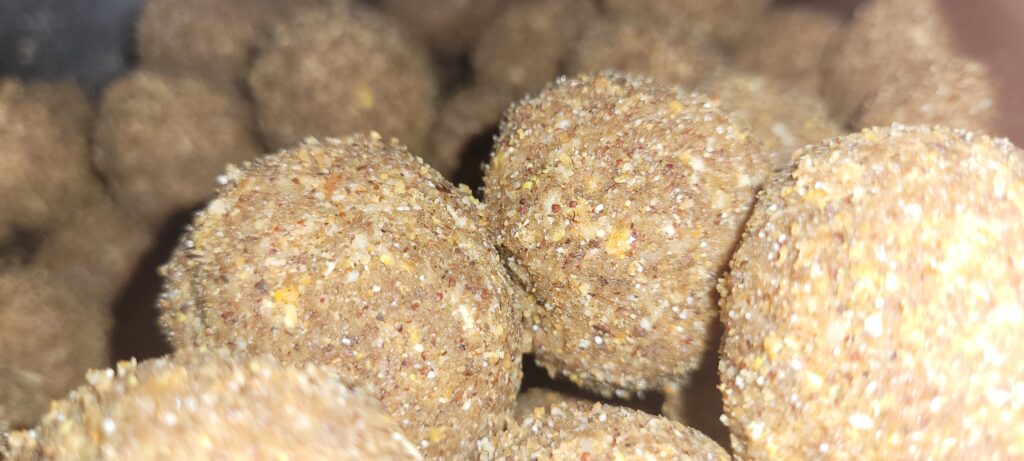Dink Laddoo wasn’t love at first bite for me.
Growing up in Kerala, this traditional Maharashtrian winter sweet was unfamiliar to me. I only discovered it after marriage—and to be honest, I didn’t enjoy it at first. The slightly bitter note of methi (fenugreek) just didn’t work for my tastebuds.
But like many heirloom recipes, Dink Laddoo revealed its magic slowly.
My mother-in-law, with all her warmth and wisdom, introduced me to the world of winter foods and why they matter. She taught me everything—from how long to roast each flour, to why haliv seeds are important for women, and how dink helps strengthen the body from within. It wasn’t just a recipe—it was a quiet tradition passed from hand to hand, year after year.
Now, what surprises me most is how much my father-in-law loves these laddoos—even with diabetes. Of course, he enjoys them in moderation, but the natural ingredients, jaggery, and wholesome flours make it a better choice than most store-bought sweets.
Eventually, I started making them myself, and over time, the taste grew on me. Today, I make a big batch every year—and this winter, it was a proud count of 100 laddoos!
Each bite now carries tradition, nutrition, and a bit of a story—from Kerala to Maharashtra, from dislike to love, from learning to mastering.
Here’s my trusted recipe.

✨ What Makes Dink Laddoo Special?
These laddoos are more than a sweet—they’re Ayurvedic power balls, especially consumed:
- In winter to build strength and warmth
- For postpartum recovery in new mothers
- By kids and elders to build immunity and energy
📝 Ingredients (Makes ~100 Laddoos)
🔥 For Roasting:
- 250 g Dink (edible gum)
- 100 g Methi seeds – lightly roasted and powdered
- 50 g Haliv seeds (garden cress) – roasted
- 250 g Nachni (ragi) flour – roasted until aromatic
- 250 g Wheat flour – roasted until nutty
- 250 g Green moong dal – roasted and powdered
- 500 g Dry coconut – grated and roasted
- 500 g Kharik (dry dates) – deseeded & powdered
- 100 g Sesame seeds – roasted
- 250 g Almonds – roughly chopped or powdered
🌿 For Flavor & Binding:
- 750 g Organic jaggery (Shendriya Gul)
- 2 tbsp Dry ginger powder (sunth)
- 1 tbsp Cardamom powder (elaichi)
- ~1 kg Ghee (as needed)
👩🍳 Step-by-Step Instructions
1️⃣ Roast & Prep All Ingredients
- Methi Seeds: Lightly dry roast, cool, and grind to a fine powder.
- Haliv, Sesame Seeds, Moong Dal, Nachni Flour: Roast each separately until aromatic.
- Dry Coconut: Roast until golden brown.
- Wheat Flour: Roast until nutty and fragrant.
- Kharik Powder: Lightly roast to remove moisture.
- Almonds: Roast and chop or powder (your preference).
2️⃣ Fry the Dink
- In a deep pan, heat ghee and fry dink until it puffs up completely.
- Let it cool and crush into small pieces using a mortar or rolling pin.
3️⃣ Prepare the Jaggery Syrup
- In a large thick-bottomed pan, melt jaggery with a few spoons of ghee until it becomes sticky and syrupy (not hard-ball stage).
- This acts as your binding agent.
4️⃣ Mix Everything
- In a wide paraat (big steel mixing tray), combine all roasted ingredients, dink pieces, cardamom, and sunth powder.
- Pour the hot jaggery syrup over the dry mix. Add warm ghee as needed.
- Mix well using a long spatula, then with your hands (be careful—it will be hot).
5️⃣ Shape the Laddoos
- While the mixture is still warm, shape into medium-sized laddoos with your palms.
- If it hardens, warm the mix slightly or apply ghee to your hands to ease shaping.
🧊 Storage & Serving Tips
- Store in an airtight steel dabba. These laddoos stay fresh for 2–3 weeks at room temperature.
- Best served with a warm glass of milk or a cup of haldi doodh (turmeric latte).
💡 Tips & Variations
- Add poppy seeds (khuskhus) for texture and richness.
- Skip methi for kids or first-timers if the bitterness is a concern (though it adds great health value!).
- Use black sesame seeds for deeper flavor and heat balance in cold climates.
- You can make half batch easily with the same ratios.
❤️ Why I Now Love Dink Laddoo
From being a reluctant taster to someone who makes 100 laddoos in a single day, this recipe has brought me closer to my new culture, and taught me that health and taste can absolutely go hand-in-hand. I now make it with joy, gratitude, and lots of ghee!